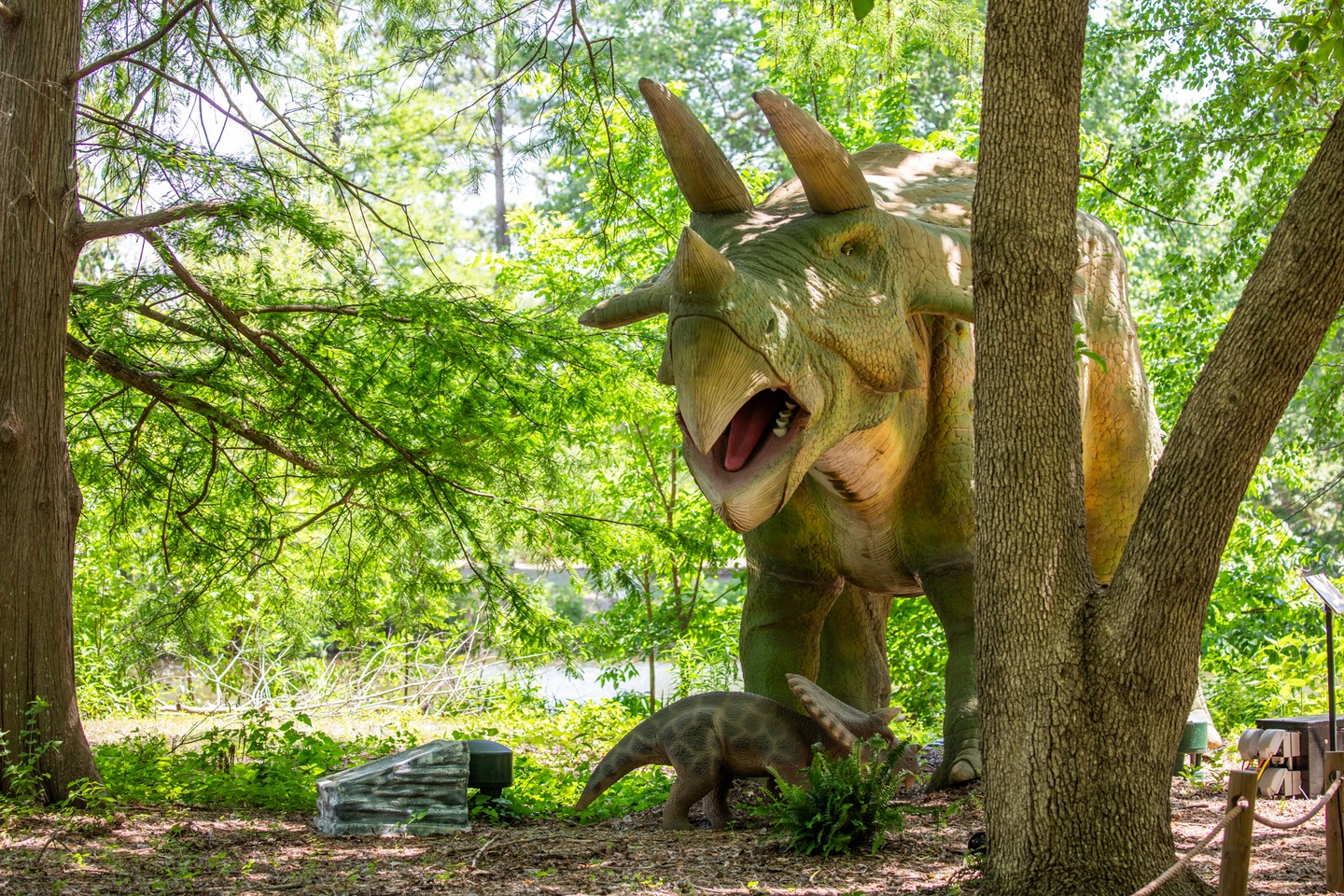- Comparative anatomy and adaptations: Triceratops vs. Southern White Rhinos
- Behavioral patterns and social structures of Triceratops and rhinos
- Conservation challenges facing modern rhinos
- Educational and conservation roles of modern zoos
- Zoorassic World: Frozen in Time exhibit at Tulsa Zoo
Triceratops and White Rhinos: Anatomical Comparison
The Triceratops roamed Earth during the late Cretaceous period, characterized by its massive frill, three formidable horns, and robust body. This dinosaur primarily used its horns and frill for defense against predators and possibly for communication among its kind. The Triceratops was a herbivore that likely grazed on low-lying plants, supported by its strong beak and jaw muscles adapted for tough vegetation.
In contrast, the southern white rhino, a modern-day herbivore, exhibits adaptations that have allowed it to thrive in present-day African savannas. The white rhino boasts two prominent horns, used for defense, territorial battles, and digging for water. Its broad mouth is ideal for grazing on grasses, showcasing evolutionary adaptations similar to those of ancient Triceratops, albeit suited for different ecological niches.
Examining both species provides insights into convergent evolution, where unrelated species evolve similar traits to adapt to comparable environments. Understanding these anatomical structures highlights the resilience and adaptability of life on Earth across millennia.
Behavioral Patterns and Social Structures
While the exact social behavior of Triceratops remains speculative due to limited fossil evidence, recent studies suggest they may have lived in groups. Herd behavior would have provided protection against predators like the Tyrannosaurus rex. Additionally, group living could have facilitated communication, resource sharing, and cooperative defense strategies.
Southern white rhinos, on the other hand, provide a clear example of social structures in modern megafauna. Typically, they form small groups consisting of females and their calves, while males are often solitary or form bachelor groups. This social structure aids in protecting young calves and sharing resources across territorial ranges. Observing rhinos enriches our understanding of survival strategies in megafauna, offering a glimpse into possible behaviors of extinct species like Triceratops.
Conservation Challenges Facing Modern Rhinos
The existence of rhinos today is jeopardized by poaching and habitat loss. Poachers target these majestic creatures for their horns, which carry significant black-market value due to misguided beliefs in their medicinal and status symbol properties. Habitat encroachment further exacerbates their decline, with commercial agriculture and urban development shrinking their natural habitats.
Conservationists employ a range of strategies to protect these animals, including anti-poaching patrols, habitat restoration, and community engagement initiatives. By supporting local communities and promoting sustainable development, conservation efforts aim to balance human needs with wildlife protection. Understanding these challenges underscores the vital role that conservation plays in preserving today’s biodiversity.
Educational and Conservation Roles of Zoos
Modern zoos like the Tulsa Zoo contribute significantly to wildlife conservation and education. Through exhibits such as Zoorassic World: Frozen in Time, zoos engage the public by showcasing prehistoric giants alongside contemporary species. These displays foster a deeper appreciation for the planet’s evolutionary history and the need for conservation in today’s changing world.
Zoos also participate in breeding programs that help maintain genetic diversity in endangered species. By collaborating with global conservation networks, zoos aid in reintroducing species into their natural habitats. Moreover, educational programs raise awareness about the significance of biodiversity and influence public attitudes towards wildlife conservation. These initiatives, exemplified by the Tulsa Zoo, highlight the transformative potential of zoos in preserving nature for future generations.
Zoorassic World: Frozen in Time Exhibit
The Zoorassic World: Frozen in Time exhibit at the Tulsa Zoo offers a unique journey through time, providing visitors an opportunity to encounter both ancient and modern-day giants. The exhibit’s focus on the Triceratops and the southern white rhino serves as a powerful reminder of the planet’s dynamic history and the precarious position of today’s wildlife.
By juxtaposing these species, the exhibit emphasizes the continuity of life and the need to safeguard our natural heritage. Visitors learn not only about the distinctions between these creatures but also their shared ecological importance. Through interactive displays and knowledgeable staff, the exhibit encourages curiosity and fosters a sense of responsibility towards preserving our planet’s biodiversity.
This exploration of Triceratops and rhinos educates and inspires, highlighting the interwoven narratives of survival, adaptation, and conservation. By maintaining a connection between the past and present, Zoorassic World: Frozen in Time creates a compelling narrative that resonates with all ages, emphasizing the critical importance of conservation and education in shaping a sustainable future.
*****
Source Description
🦖 Then vs. Now: Triceratops & Tulsa Zoo’s Rhino Trio! 🦏
At Zoorassic World: Frozen in Time, you’ll meet the mighty triceratops, a three-horned dinosaur that ruled the late Cretaceous period. With its large frill, sturdy frame and powerful horns, the triceratops likely used its features for protection and communication.
Tulsa Zoo is home to three two-horned giants: Hodari, Sally and Rudo, our southern white rhinos! Rhinos are herbivores built for strength, but unlike the extinct triceratops, they still walk the Earth and need our help to stay that way.
Come explore the chilling past and the incredible present at Zoorassic World: Frozen in Time, now open at Tulsa Zoo!
Learn more using the link in our bio.


